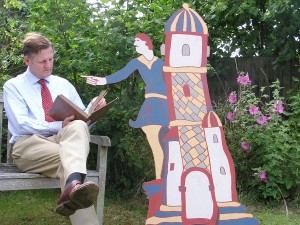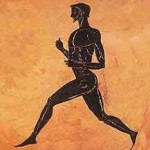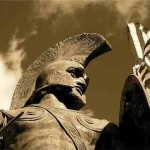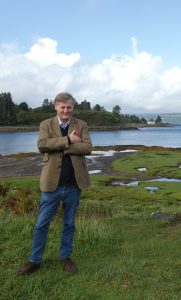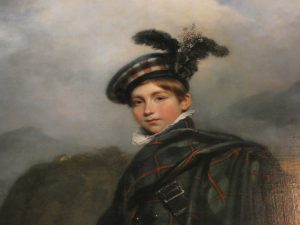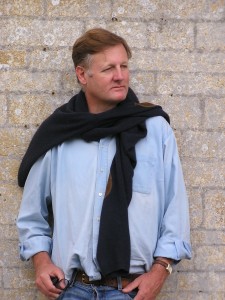 RUPERT WILLOUGHBY is an experienced public speaker to audiences of all ages and backgrounds. A classicist and medievalist by training, he speaks on a broad range of historical periods and themes. His approach is to inspire audiences by applying a light, humorous touch. One recent client wrote: ‘Your talk was much appreciated by everyone who heard you. Somehow you manage to bring a period of history to life and one can imagine what life was like not only for the well off and well known characters of the time, but for the more ordinary people as well. It was full of humour and insight …’ The comment of an Arts Society reviewer: ‘Illuminating facts and gentle humour combined. Perfect!’
RUPERT WILLOUGHBY is an experienced public speaker to audiences of all ages and backgrounds. A classicist and medievalist by training, he speaks on a broad range of historical periods and themes. His approach is to inspire audiences by applying a light, humorous touch. One recent client wrote: ‘Your talk was much appreciated by everyone who heard you. Somehow you manage to bring a period of history to life and one can imagine what life was like not only for the well off and well known characters of the time, but for the more ordinary people as well. It was full of humour and insight …’ The comment of an Arts Society reviewer: ‘Illuminating facts and gentle humour combined. Perfect!’
Rupert was invited to join the Arts Society (formerly NADFAS) Directory of Lecturers in July 2011, having successfully completed their gruelling selection process (including the legendary ‘ordeal by tweed’). To meet the requirements of his Arts Society clients, his current 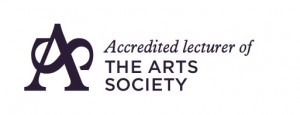 repertoire has a strong ‘decorative and fine arts’ bias. Both long and short synopses of each hour-long talk, and of his Special Interest or Study Days, ‘The Normans in England, 1066 – 1215’ and ‘Greek Salad: The Essentials of Western Civilisation’ can be found on this page, together with a selection of reviews.
repertoire has a strong ‘decorative and fine arts’ bias. Both long and short synopses of each hour-long talk, and of his Special Interest or Study Days, ‘The Normans in England, 1066 – 1215’ and ‘Greek Salad: The Essentials of Western Civilisation’ can be found on this page, together with a selection of reviews.
For Rupert’s attempt to epitomise both the spirit and content of these lectures, see his April 2012 blog, ’Wooing NADFAS: Setting Out One’s Stall at the Annual Directory Meeting’ (http://www.rupertwilloughby.co.uk/archives/912). Rupert’s one-minute speech at the Annual Directory Meeting on 14 March 2016 was about his ‘Basingstoke’ talk. Read the full text here: http://www.rupertwilloughby.co.uk/cuttings/basingstoke-and-its-contribution-to-world-culture-read-the-book-hear-the-lecture/
Rupert has also produced a series of short films to promote his work, which can be viewed on his YouTube page – https://www.youtube.com/channel/UCPDtGkZU6cr0JBzzAjIi6EQ.
Further lecture topics are available on application. Please address enquiries to RupertWilloughby@btinternet.com.
Rupert Willoughby specialises in the domestic and social life of the past. He is the author of the best-selling Life in Medieval England for Pitkin and of a series of popular histories of places, including Chawton: Jane Austen’s Village and Basingstoke and its Contribution to World Culture.
Rupert has published numerous articles, contributes regular obituaries to The Daily Telegraph, undertakes private research commissions including histories of houses, occasionally broadcasts to the nation and is an experienced lecturer, whose repertoire ranges from the ancient Greeks, through the life and personalities of the Middle Ages to Modernist architecture.
CURRENT LECTURES
Why remember a battle that took place over two and a half thousand years ago? Examining the influence of ancient Athens on our art and culture, Rupert reveals Marathon as the victory that saved ‘Western Civilisation’. Eye-opening, edge-of-your-seat stuff.
One of the world’s most popular athletic events commemorates Pheidippides’s epic run from the battlefield of Marathon to his native Athens. Apart from the amazing courage of Pheidippides, why remember a battle that took place over two and a half thousand years ago? Since the 19th century, historians have argued that it was a crucial event, one that had decided ‘the whole future of human civilisation’. As John Stuart Mill put it, ‘the Battle of Marathon, even as an event in English history, is more important than the Battle of Hastings’. Rupert demonstrates that the athleticism of the Greeks was crucial to their success. He explores the ruins of Olympia, one of the key cultural sites in ancient Greece, where the four-yearly Olympic Games were held; and connects them not only with the modern Olympics, but also with school sports-days and even the game of rugby. Re-creating the background and the battle itself in thrilling detail, Rupert argues that Marathon was, indeed, the battle that saved ‘Western Civilisation’. Eye-opening, edge-of-your-seat stuff.
COOL MARBLE! THE ESSENTIAL GUIDE TO GREEK SCULPTURE
From the controversial Parthenon or ‘Elgin’ marbles to the Venus de Milo, most celebrated among the ‘naked Aphrodites’, here is a chance to meet the Ancient Greeks in the raw. Contains nudity!
The Ancient Greeks invented the human portrait and their sculpture formed the basis of European art. Arguably, it has never been bettered. They produced statues of such beauty and realism that men are said to have fallen in love with them. A Classical scholar and teacher, Rupert elucidates some of their finest artistic expressions, including the controversial Parthenon or ‘Elgin’ marbles (the story of which is recounted in detail) and the Venus di Milo, celebrated survivor of a craze for ‘naked Aphrodites’.
A mighty Persian army sweeps into Greece. For Sparta to be saved, the King must die. So says the far-famed Oracle at Delphi. Leonidas and his 300 warriors set out for Thermopylai, ready to lay down their lives. From austere Sparta to glittering Delphi, re-trace one of the greatest adventures in history.
In 480 BC, ten years after their defeat at Marathon, the Persians under King Xerxes launch a second invasion of Greece. Leonidas, King of Sparta, plans to block their advance. Famously men of few words, solely dedicated to the profession of arms, the Spartans are the supreme warriors of their time, unbeaten in any major battle. Leonidas consults the Oracle at Delphi and is assured that Sparta will indeed be saved – but at the cost of his own life. 300 hand-picked soldiers accompany him to the narrow Pass of Thermopylai, where they will hold off the Persian advance. Told to lay down their arms, they invite Xerxes to ‘Come and get them’. This is not just an account of Sparta and the artistic wonders of Delphi, with which it was closely associated. It is also the stirring tale of one of the most gallant military actions in history.
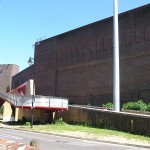 BASINGSTOKE AND ITS CONTRIBUTION TO WORLD CULTURE
BASINGSTOKE AND ITS CONTRIBUTION TO WORLD CULTURE
Rupert describes the post-war development of a typical English town. What motivated the planners who imposed the absurdities of Modernist architecture on our landscape? Hilarity is guaranteed.
One of the most derided towns in England, renowned for its dullness, Basingstoke is distinguished only by its numerous roundabouts and absurd Modernist architecture. Rupert explains that the post-war planners, who inflicted such features as ‘the Great Wall of Basingstoke’ on the town, were politically-motivated and bent on destroying all traces of its past. He reveals the nobler Basingstoke that is buried beneath the concrete, and the few historic gems that have survived the holocaust. Hilariously told, it is a story that neatly illustrates the ugliest episode in England’s architectural history. As Betjeman wrote prophetically, ‘What goes for Basingstoke goes for most English towns’. (See Rupert’s seven-minute promotional film, ‘The Great Wall of Basingstoke’, at https://www.youtube.com/watch?v=AbccTZ6A1nQ&t=11s.)
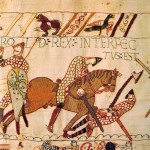 THREADS OF HISTORY: THE WORLD OF THE BAYEUX TAPESTRY
THREADS OF HISTORY: THE WORLD OF THE BAYEUX TAPESTRY
In this lively introduction to the tapestry – so much more than the story of Hastings – Rupert unravels some of its mysteries, places it in the context of its age and firmly establishes it as a landmark in the history of Western art.
Commissioned by the Bishop of Bayeux who fought at Hastings, executed by skilled English craftsmen, the Bayeux Tapestry is the last survivor of a vanished art form. Rupert Willoughby presents a lively introduction to the tapestry – so much more than the story of Hastings – in which he unravels some of its mysteries, places it in the context of its age and firmly establishes it as a landmark in the history of Western art. With its lively illustrations of languid, party-loving, moustachioed Englishmen, of the cavalcades of noble huntsmen and of the snorting Norman cavalry poised to charge into battle, the Tapestry is the next best thing to a moving picture from the time.
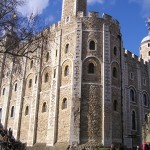 THE NORMANS – CONQUEST AND LEGACY
THE NORMANS – CONQUEST AND LEGACY
An account of the orgy of building after the Conquest that all but effaced the fabric of Saxon England, with the focus on individual patrons and their lives.
The Norman conquerors of England were the roughest of company, who came not to civilise, but to seize. A mere eleven men in Duke William’s inner circle enjoyed an unprecedented bonanza, receiving almost half the land of the conquered kingdom. There followed an orgy of building in what was described as ‘a new manner’ – castles, churches, monasteries and cathedrals – that all but effaced the fabric of Saxon England. It was their way of showing us who was in charge. In describing the mass of post-Conquest masonry, Rupert focuses on individuals, like the deeply unpleasant Baldwin de Redvers, lord of the Isle of Wight, where his legacy endures. He offers an insight into their lives – and the disgusting details of William the Conqueror’s funeral. (See Rupert’s seven-minute promotional film, ‘Conquest and Legacy – the Isle of Wight’, at https://www.youtube.com/watch?v=n0xejJtoUuk&t=7s.)
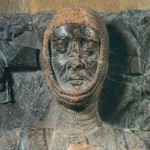 KNIGHT ERRANT: THE LIFE AND ADVENTURES OF WILLIAM THE MARSHAL
KNIGHT ERRANT: THE LIFE AND ADVENTURES OF WILLIAM THE MARSHAL
Celebrating a key figure in the age of Magna Carta, Rupert stirringly evokes a gorgeous world in which the knight was dominant. In their coats of mail like silk shirts and their golden spurs, these were ‘the angels men complain of, who kill whatever they come upon’.
Reckoned by a contemporary to be ‘the best knight who ever was or will be’, William the Marshal was the classic knight errant, who made his name – and a fortune in ransoms – on the tournament circuit in northern France. Such was William’s renown that he rose to be Regent of England during the minority of Henry III, uniting the nation and saving the English monarchy. Rupert compares William’s verse biography with the Arthurian romances of his contemporary, Chrétien de Troyes, and finds fiction merging with reality. He stirringly evokes a gorgeous world in which the knights were dominant. In their coats of mail like silk shirts and their golden spurs, these were ‘the angels men complain of, who kill whatever they come upon’.
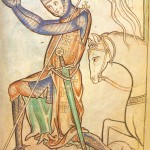 SIMON DE MONTFORT – AT HOME AND AT WAR
SIMON DE MONTFORT – AT HOME AND AT WAR
Rupert leads the audience on a room-by-room tour of thirteenth-century Odiham Castle in Hampshire (now a romantic ruin), describing what is known or can be surmised about its furniture and decoration – and reveals intimate details of Simon’s home life.
Now a romantic ruin, Odiham Castle, in north Hampshire, was once the residence of Simon de Montfort and his wife Eleanor, sister of Henry III. Rupert draws upon both written and archaeological evidence to reconstruct the castle and the home life of the couple. He leads the audience on a room-by-room tour, describing what is known or can be surmised about its furniture and decoration. He discusses clothing, literacy and language, the Montforts’ turbulent married life and Simon’s remarkable piety, and ends with a moving description of his death in 1265, at the Battle of Evesham.
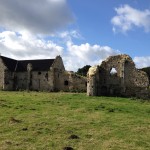 SPECIAL INTEREST OR STUDY DAYS
SPECIAL INTEREST OR STUDY DAYS
THE NORMANS IN ENGLAND, 1066 – 1215
1. The World of the Bayeux Tapestry. 2. Conquest and Legacy. 3. Knight Errant: The Life and Adventures of William the Marshal.
Rupert Willoughby presents a trilogy of talks about the Normans – from an unravelling of the Bayeux Tapestry to an account of the orgy of building after 1066 that all but effaced the fabric of Saxon England, and, to conclude, a celebration of the life of William the Marshal, a characteristic Norman knight of the Magna Carta period.
‘These were extremely well-researched lectures given by a very knowledgeable and fluent speaker’ (East Grinstead).
‘Everyone loved it. He delivered every part extremely well and made the whole thoroughly enjoyable’ (Moor Park).
‘[We,] and indeed everyone who came to your Study Day yesterday, were enthralled by your fascinating description of England under the Normans. The Bayeux Tapestry, such an entrancing piece of needlework, really came to life with your amusing and informative discourse. And William the Marshal, about whom I’m afraid not many of us knew very much at all, is a figure who deserves a far more prominent place in history. Thank you so much for giving Pewsey Vale such an interesting, informative and entertaining day. Judging by the comments I heard during coffee and lunch, yours was one of the most well-received and enjoyable sessions we have had!’ (Pewsey Vale)
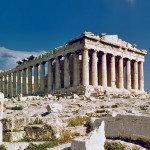 GREEK SALAD: THE ESSENTIALS OF WESTERN CIVILISATION
GREEK SALAD: THE ESSENTIALS OF WESTERN CIVILISATION
1. Marathon! 2. Cool Marble! 3. Thermopylai!
The Ancient Greeks were the founders of Western civilisation. Rupert explains how key cultural achievements would never have occurred without the Athenian victory at Marathon in 490 BC. He describes the invention by Greek sculptors of the human portrait, their work being the basis of European art. The day concludes with a thrilling account of the Battle of Thermopylai in 480, with visits to Sparta and Delphi along the way.
A SELECTION OF REVIEWS
Marathon!
Basingstoke and its Contribution to World Culture
‘Such an entertaining lecture which struck just the right note for the season. The content was so well crafted with clear slides and delivered with such wit and in an entertaining style. To the extent he could he truly covered the artistic delights of this town. Rupert held our interest throughout all aspects of his subject and many members commented that this lecture was one of the best this year. Excellent.’ (Romsey)
‘Excellent. The lecture was delivered in a very clear, competent manner [and was one] that could be “heard” on different levels. It gave us a very informative insight into local planning … but was also (in parts) very light-hearted.’ (Grayshott)
‘Excellent. This was a most informative lecture, which covered many aspects of the development of town planning with Basingstoke being an extreme example of much that has happened elsewhere.’ (Beckenham)
‘Excellent. Our understanding of why so many town centres are rather bleak was explained with great clarity.’ (Rugby)
‘Excellent. Thought-provoking, a very different subject for consideration, very smoothly presented.’ (Royal Leamington Spa)
‘Excellent. A serious subject presented with humour in an engaging and accessible manner.’ (Storrington)
‘A quirky tongue-in-cheek lecture with an unusual approach to the subject.’ (Sevenoaks)
‘Mr Willoughby had an immediate rapport with his audience, was an assured speaker with a light touch, good sense of humour and relaxed manner. He knew his subject well, it had been very well researched and the lecture was well illustrated. In an unusual topic he held the attention of his audience well.’ (Exeter)
‘Excellent. Interesting and amusing.’ (Exe)
‘Excellent. Interesting, informative and thought-provoking.’ (Portsdown)
‘A most amusing and thought-provoking lecture. Outstanding.’ (Alton)
‘Excellent. A highly amusing and entertaining talk.’ (Canterbury)
‘Excellent. He is an excellent speaker and his humour was much appreciated by members. A most enjoyable lecture.’ (Cantab)
‘An unusual subject for a lecture which had a very amusing beginning, a serious central theme and a light ending. Expertly delivered with good digital slides and very well received by an appreciative audience. An excellent end to our year of lectures.’ (Goring)
‘A great lecture, with well presented information and a humane side … Excellent.’ (Northleach)
‘An enjoyable and well-received lecture, at once amusing and thought-provoking, stimulating a good buzz of discussion afterwards among members. Particularly good, clear and confident delivery. Excellent.’ (Horsham)
‘Good speaker and unusual subject but was interesting, humorous and informative. It was very well delivered. Excellent.’ (West Wycombe)
‘Really good lecture. Content was well presented and prompted much thought about changes in the 1950s and 60s in the name of modernisation.’ (Malling)
‘A thoroughly entertaining lecture, combining both serious content and humour. Outstanding.’ (Hart)
‘Rupert Willoughby gave an amusing, concise and informative lecture. One of the best I have attended. Good social history, lightened with humour. A broad self-opinion by the lecturer aroused much thought, to be commended.’ (Camberley)
‘Well delivered, lively and amusing.’ (Leatherhead)
‘Excellent style of presentation … Very nice man!! Excellent.’ (Sheffield)
Threads of History: The World of the Bayeux Tapestry
‘I am seldom moved to comment on lectures, but I felt I had to write to you concerning yesterday’s lecture by Mr Willoughby. It was simply brilliant, entertaining, informative and beautifully delivered. This man is a gem, please can we have him again, doesn’t matter what the subject, he could make the phone directory riveting.
‘I was particularly impressed with his explanation of the reason the tapestry was made, so different from the commonly accepted one that it was a triumph of one man over another. His explanation that it showed the dangers of breaking solemn oaths made so much more sense. It was revelatory.
‘This was one of the best lectures I have ever heard, thank you so much for arranging it.’ (A member of the Arts Society, Arden, to her committee, 1 Nov 2019)
‘Outstanding. A really enjoyable evening, thanks to Rupert’s passion for history. He made the Tapestry become alive with his remarkable narrative skills.’ (Brussels)
‘Outstanding. It was a great delight to welcome Rupert back … His company and lecture were rated ‘outstanding’ by all involved. “A fascinating history lesson”, “in-depth information”, “an excellent interpretation of the Tapestry, which I now appreciate much more”, “a very easy to listen to lecture” – We look forward to another Willoughby lecture in the future.’ (Holland and Kesteven)
‘Outstanding. Particularly effective use of wit … good and well-researched information and an engaging, fluent style.’ (Portsea)
‘Humorous and very informative. Greatly enjoyed by all present. Excellent.’ (Fife)
‘Rupert is a wonderful speaker and the audience were enthralled by Rupert himself, his presentation skills and the fascinating subject … Excellent. (Cheam)
‘Rupert’s presentation was mellifluous and highly proficient. He brought the whole story of the Bayeux Tapestry to life and one member said it was one of the best lectures ever … Excellent.’ (Hillingdon)
‘A captivating speaker, sociable and very entertaining. Lecture well presented and most interesting. The background and content of the Bayeux Tapestry was covered with great expertise. Outstanding.’ (Reigate)
‘Very well received. A new look at an old subject, and a very accessible lecture. Excellent.’ (Abingdon)
‘This was a very well prepared lecture, excellently and clearly delivered. It dealt with the world of the Tapestry in its broad context, as well as its manufacture and subsequent history, giving many insights into this world as revealed in its images and related artefacts. The lecture was very well received by the audience who responded very warmly to the speaker, his message and his gentle humour. It left many of us with a strong desire to see the tapestry again with our new understanding of its images and its background. To sum up, this was an excellent lecture.’ (Devon)
‘Delivered “The World of the Bayeux Tapestry” with ease, humour and depth of subject. Excellent.’ (Harrogate)
‘A fascinating lecture, enhanced with touches of humour … Excellent.’ (Arun)
‘Rupert had a very clear delivery, commented upon by many members. He was witty and knowledgeable … Partly as a result of this lecture we gained 4 new members. We do not take questions from the floor but after the lecture Rupert was very happy to talk to people to discuss his lecture with them. Outstanding.’ (Ealing)
‘An extremely well researched lecture, delivered clearly with gentle humour and great detail, all the time relating the Tapestry to relevant historical events, and even involving our local village, Bosham. The lecture was supported by excellent images. Excellent.’ (City of Chichester)
‘An excellent lecture, very informative and strongly recommended if a society is planning a visit to Normandy, or Leek (the copy!). Very pleasant, clear voice and smatterings of humour. Would be worth having for a study day to go into greater detail. Excellent.’ (East Grinstead)
The Normans – Conquest and Legacy
‘Outstanding. This lecture was so well received by our members. A good, well-organised presentation. Good clear images. The importance and relevance of the Norman Conquest clearly explained … A first-class evening.’ (Hexham)
‘Excellent. A well-illustrated and clearly-delivered lecture.’ (New Forest)
‘Excellent. Rupert was an entertaining and interesting lecturer. A solid, Excellent performance. His descriptions of the Norman overlords were graphic and well illustrated.’ (Beaconsfield)
‘Excellent. His lecture was both informative and entertaining and was thoroughly enjoyed by our members. He has the happy knack of bringing history to life and making facts and figures interesting and relevant.’ (West Wales)
Simon de Montfort – at Home and at War
‘This was a most enjoyable lecture and an entirely new subject … Some members felt that this was the best ever lecture … There were many humorous asides … Our annual luncheon followed so questions were taken in the foyer and Mr Willoughby was most approachable. Excellent.’ (Runnymede)
‘Excellent.’ (Kensington and Chelsea)
Various
(Rupert has long experience of lecturing to local historical societies, associations and clubs. Here are some recent testimonials:)
‘I’d like to say how much I enjoyed your talk yesterday on Oscar Wilde and Reading Gaol. You had a fantastic turn out – just how many people did you manage to squeeze into that room? It was an engaging talk, injecting some humour into the macabre facts that you had to deal with. Absolutely brilliant! Your talk was so good it kept me there straining to hear it against the background noise …’
‘Please pass on to Rupert Willoughby our thanks and congratulations on his superb hour-long guide to the Bayeux Tapestry, which we were honoured to receive yesterday. Rupert’s enthusiasm for, and deep knowledge of, his subject made it come alive for us. Well done, Sir!’
‘Your talk was much appreciated by everyone who heard you. Somehow you manage to bring a period of history to life and one can imagine what life was like not only for the well off and well known characters of the time, but for the more ordinary people as well. It was full of humour and insight and I am sure we shall all look at pictures of the Bayeux Tapestry with new eyes. Thank you very much.’
‘I am writing to say how much I enjoyed last Thursday’s Lunch-Time Lecture by Mr Rupert Willoughby on the subject of Simon de Montfort. Would it be possible, at a future date, for Mr Willoughby to give a further talk on this very interesting and important subject?’
‘A wonderful talk … enjoyed very much by our members.’
‘The lecture was delivered with panache and was followed by a lively question and answer session … All in all a splendid and informative afternoon.’
‘You manage to make history really come alive.’
